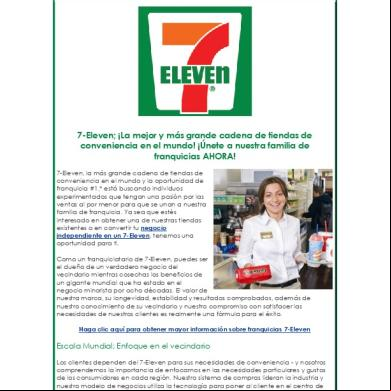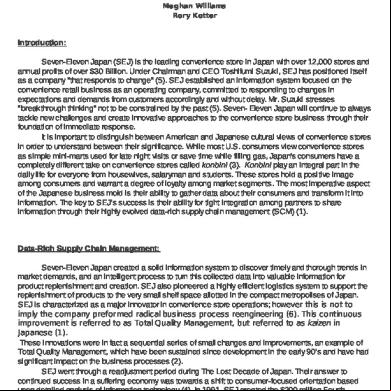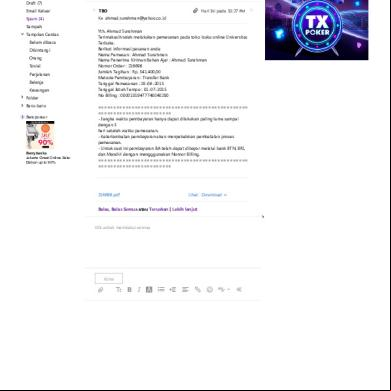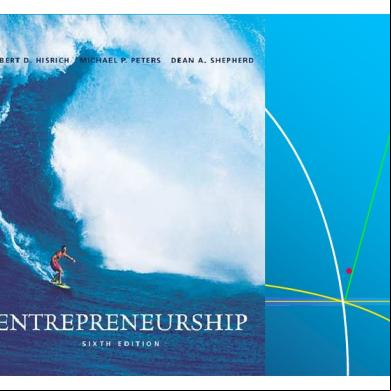7 Eleven 1f602b
This document was ed by and they confirmed that they have the permission to share it. If you are author or own the copyright of this book, please report to us by using this report form. Report 3i3n4
Overview 26281t
& View 7 Eleven as PDF for free.
More details 6y5l6z
- Words: 1,734
- Pages: 9
UNIVERSITY OF REDLANDS
7-Eleven International Strategy: Indonesian Market Arman Tabatabaei INTB 692W Aug 2013
1
Arman Tabatabaei INTB 692 Professor Zikri 7-Eleven International Strategy: Indonesian Market Are strong strategies poised for success? The grim reality is that some 90% of strategies do not live up to expectations. At least writer Alaina Love, appears to think so. She further states that the three stages of any successful strategy are the following: “framing the problem, energizing the workforce, and equipping the organization for success”. Wal-Mart, Blockbuster, and GM are only a few of the numerous companies that failed to realize their strategies, especially in the global ecosystem. With increasing complexity and fiercer competition, what is the incentive of an international presence? In retail, the prospect of new markets is perhaps the most desirable especially in the event that domestic targets have become saturated. Most noteworthy is 7-Elevens surprising decision in 2009 to enter Indonesia. In this paper I will explore the methodologies and strategies of 7-Eleven entering Indonesia and explain what other firms can glean from 7-Eleven in order to bolster their own growth and expansion internationally. What if I told you convenience retailing started out with a block of ice in 1927? Well that is precisely how this retailing concept was born. Mr Jefferson Green, an enterprising Southland Ice Company employee, began offering bread, eggs, and milk from the ice house dock. One of the founders of Southland Ice Company realized the potential of providing customers everyday staples within convenient hours and distance. He invariably expanded the concept to 21 retail ice docks. With the advent of Ford automobiles, Southland Ice Company began selling gasoline in 1928. The selling of alcohol and liquor further boosted sales dramatically during the late 1930's. And by 1946 Tote'm changed their name to 7-Eleven to reflect the stores' new, extended hours: 7 a.m. Until 11pm Seven days a week. In 1969 the company went international, riding on the hype of Slurpees, and opened its first stores in Canada. 7-Eleven reached many “firsts” in its industry and has banked on numerous great ideas in order to remain successful. The rest, as they say, is history. Today 7-Eleven boasts
Arman Tabatabaei INTB 692 Professor Zikri approximately 50,900 stores and is beloved by all Business Bureaus including making Forbes Top Franchise's list for years. Following chart represents a very interesting point in which the company had predicted that it will reach 50,000 plus stores by 2017, but it was achieved by 2013 about four years ahead of their forecast.
There are four core challenges 7-Eleven specifically has to address: 1. Selecting the foreign market to enter, 2. How to respond to changing customer demand, fast-moving economy and competitive environment, 3. How much to adapt while retaining the brand DNA, and finally, 4. How does one facilitate expansion and be operationally viable? Why Indonesia of all places? Firstly, there are several factors that contribute. The nation has to be politically stable and a developing nation, based on an economic forecast. It is rumored that 7Eleven teamed up with a private Economic analysis consultation firm, but these are simply
Arman Tabatabaei INTB 692 Professor Zikri speculations. PT Bank Danamon Indonesia, tbk highlights the economic market in 2011 on page 3: a 6.4% projected economic growth. Moreover, Mr. Metic Cakanyildirim at the University of Dallas states that “from 2003 to 2011, 50 million people in Indonesia entered into the middle income bracket with disposable income of $2-20 per day.” This satisfies another criteria of selecting a foreign market as well, identifiable growing target market. The nation should be a free market, meaning the economy is based on the complex interaction of supply and demand with little or no government control. Lastly, in the economic forecast, there should be no predictable dramatic upswing in inflation or private-sector. Now that the economic status of the nation checks out, the question becomes “how?” The following is extracted from the 7-Eleven annual report: 7-Elevens Business Model consists of 5 key elements: 1. A differentiated merchandising strategy 2. Utilization of 7-Eleven's retail information system 3. Managed distribution 4. Providing a convenient shopping environment; and 5. A unique franchise model Let's turn our attention on number 5: A unique franchising model. It is estimated that 80 percent of 7Elevens are franchised in the U.S. and 7-Eleven Japan is the largest international license holder that opened its 10,000th store a decade ago. 7-Eleven corporation has adopted some of the infrastructure and ideas of 7-Eleven Japan. Convenience has become a universal concept but that doesn't mean the same thing everywhere. As is illustrated above in the Business Model, 7-Eleven has developed a strong strategy to holster and develop their brand both domestically and internationally. 7-Eleven has focused on a simple and adaptable strategy globally; provide easy convenience. In the table below from 2005 Harvard Business School clearly shows the convenience and mini mart store dominance by 7-Eleven.
Arman Tabatabaei INTB 692 Professor Zikri
In the early days 7-Eleven spread its wings slowly by growing strategically in the suburbs. Nowadays, the entry strategy has become to target urban markets and tailor stores to local taste. In Taiwan, customers can service their bicycles or make a photocopy. In fact, 7-Eleven has become so ubiquitous in Taiwan that the Taiwanese government used the stores as a location to conduct a free health checkup on all its citizens. In Hong Kong customers can pay their phone and utility bills at 7-Eleven. These unique offerings can increase traffic significantly. So the questions now are: What was the Indonesian customer looking for and where should the retailer position itself? The Indonesian market has certain traits that 7-Eleven has never addressed before: Nongkrong. It is an activity, rather an inacticity deeply embedded in the culture where people simply hang out and do nothing. Following this tradition, people typically gather at street markets, local eateries, McDonalds, anywhere really that has chairs and provides a moment of reflection from the hustle of the busy streets of Indonesia. On top of that, Indonesia has embraced the internet with approximately 20 to 30 million s all within the age range of 15-20. 7-Eleven made it a point to study the culture, habits
Arman Tabatabaei INTB 692 Professor Zikri and tastes of the Indonesian population. What emerged from the study was that Indonesian youth, the ones with a disposable income of $2-20 per day, lacked a place where could simply hang out and be online. How did 7-Eleven cater to them? The following are some of the unique ways: 24 hours stores, hassle-free parking, air-conditioned, an environment where bands are encouraged to come and play, and most importantly- wireless connectivity for everyone. This ensures that the groups stay and continue to purchase and consume from 7-Eleven. What this is indicating is that 7-Eleven has focused more on the experience than convenience, which is the dilemma of international strategy: the tradeoff between flexibility and brand equity preservation. “The localization strategy of 7-Eleven is more than just quirky; it’s a good business model, according to Torsten Stocker, a China-based partner at strategy consulting firm Monitor Group. "[7-Eleven] has local partners who understand the environment in their market very well,” he stated in an email. “This allows them to grow very rapidly and at much lower investment. (Alaina Love page 3)” 7-Eleven practices differentiation to avoid direct competition with larger supermarket chains. This includes smaller stores, more store locations, and narrower product lines. Also, 7-Eleven has brand specific products and services. Services have been described above such as the WiFi. Products include daily delivered fried rice which is specific to certain locations. The trademarked Slurpee and Big Gulp are also distinguishably 7-Eleven brand magnets. Perhaps 7-Elevens most effective strategy is something called a market concentration. For example, in Japan there are a cluster of 50-60 stores in a small geographic area ed by a distribution center. This is essentially a high concentration of stores within one area. So what are the effects of market concentration? For one, it provides greater familiarity. While studying consumer behavior, I noticed that the more a consumer is familiarized with a brand, the more they are likely to trust and conduct business with said brand. Efficiency also emerges from market concentration,
Arman Tabatabaei INTB 692 Professor Zikri regardless of global presence, for example; efficient construction of product base and efficient distribution structures. This essentially allows 7-Eleven to receive products in a cluster of stores as opposed to individual and disseminated stores. Moreover, there is improved efficiency in guiding store franchised stores. 7-Eleven is engaged with their franchisees and sends out a consultant to meet with the owners frequently. Within a market concentration, tactics can be devised in order to amplify everyone’s profits by using economies of scale and scope. This also encourages proprietary product lineup and quicker checkouts. Albeit convenience stores obviously do not have the capacity of WalMart and their supply chain system, 7-Eleven does have a strong information and analysis infrastructure guiding many decisions on a daily basis. Conclusively, 7-Eleven has not only forged a strong brand, but developed a competitive advantage by being unique in each market it enters. They empower franchisees and seek them out because of their superior knowledge and experience in their markets. Here is a SWOT analysis done on this company to point out some of the advantages and disadvantages.
Arman Tabatabaei INTB 692 Professor Zikri In Indonesia, 7-Eleven needs to be aware of emerging competition and similar firms pursuing the same target market. These are the threats of being the first. Here is a quick questionnaire conducted on the image of 7-Eleven and the respondents were asked what they associate with 7-Eleven. The results show that 7-Eleven is associated with good hours, it is a youthful environment, and it is nearby. Which is what they stated was their goal in their 2011 annual report: “we recognized the important role of "close by convenient stores." (annual report page 22)” Lastly, I have included a SWOT analysis of 7-Eleven to accompany this paper.
Arman Tabatabaei INTB 692 Professor Zikri Reference
7-Eleven. (2012). –History. Retrieved from http://corp.7-eleven.com/AboutUs/History/tabid/75/Default.aspx
Love, A. (2011). Wal-mart’s epic strategy fail. Bloomberg Business Week. Retrieved from http://www.businessweek.com/managing/content/mar2011/ca20110328_966846.htm
PT Bank Danamon Indonesia, tbk. (2011). Indonesia economic outlook 2011 another good year? [Data file]. Retrieved from http://www.kadin-indonesia.or.id/enm/images/dokumen/KADIN-168-4895-17022011.pdf
The University of Texas at Dallas. (n.d.). Supply chain management Seven Eleven Japnan [Data file]. Retrieved from http://www.utdallas.edu/~metin/Or6366/Folios/IntroStrategy/scseveneleven.pdf
7-Eleven International Strategy: Indonesian Market Arman Tabatabaei INTB 692W Aug 2013
1
Arman Tabatabaei INTB 692 Professor Zikri 7-Eleven International Strategy: Indonesian Market Are strong strategies poised for success? The grim reality is that some 90% of strategies do not live up to expectations. At least writer Alaina Love, appears to think so. She further states that the three stages of any successful strategy are the following: “framing the problem, energizing the workforce, and equipping the organization for success”. Wal-Mart, Blockbuster, and GM are only a few of the numerous companies that failed to realize their strategies, especially in the global ecosystem. With increasing complexity and fiercer competition, what is the incentive of an international presence? In retail, the prospect of new markets is perhaps the most desirable especially in the event that domestic targets have become saturated. Most noteworthy is 7-Elevens surprising decision in 2009 to enter Indonesia. In this paper I will explore the methodologies and strategies of 7-Eleven entering Indonesia and explain what other firms can glean from 7-Eleven in order to bolster their own growth and expansion internationally. What if I told you convenience retailing started out with a block of ice in 1927? Well that is precisely how this retailing concept was born. Mr Jefferson Green, an enterprising Southland Ice Company employee, began offering bread, eggs, and milk from the ice house dock. One of the founders of Southland Ice Company realized the potential of providing customers everyday staples within convenient hours and distance. He invariably expanded the concept to 21 retail ice docks. With the advent of Ford automobiles, Southland Ice Company began selling gasoline in 1928. The selling of alcohol and liquor further boosted sales dramatically during the late 1930's. And by 1946 Tote'm changed their name to 7-Eleven to reflect the stores' new, extended hours: 7 a.m. Until 11pm Seven days a week. In 1969 the company went international, riding on the hype of Slurpees, and opened its first stores in Canada. 7-Eleven reached many “firsts” in its industry and has banked on numerous great ideas in order to remain successful. The rest, as they say, is history. Today 7-Eleven boasts
Arman Tabatabaei INTB 692 Professor Zikri approximately 50,900 stores and is beloved by all Business Bureaus including making Forbes Top Franchise's list for years. Following chart represents a very interesting point in which the company had predicted that it will reach 50,000 plus stores by 2017, but it was achieved by 2013 about four years ahead of their forecast.
There are four core challenges 7-Eleven specifically has to address: 1. Selecting the foreign market to enter, 2. How to respond to changing customer demand, fast-moving economy and competitive environment, 3. How much to adapt while retaining the brand DNA, and finally, 4. How does one facilitate expansion and be operationally viable? Why Indonesia of all places? Firstly, there are several factors that contribute. The nation has to be politically stable and a developing nation, based on an economic forecast. It is rumored that 7Eleven teamed up with a private Economic analysis consultation firm, but these are simply
Arman Tabatabaei INTB 692 Professor Zikri speculations. PT Bank Danamon Indonesia, tbk highlights the economic market in 2011 on page 3: a 6.4% projected economic growth. Moreover, Mr. Metic Cakanyildirim at the University of Dallas states that “from 2003 to 2011, 50 million people in Indonesia entered into the middle income bracket with disposable income of $2-20 per day.” This satisfies another criteria of selecting a foreign market as well, identifiable growing target market. The nation should be a free market, meaning the economy is based on the complex interaction of supply and demand with little or no government control. Lastly, in the economic forecast, there should be no predictable dramatic upswing in inflation or private-sector. Now that the economic status of the nation checks out, the question becomes “how?” The following is extracted from the 7-Eleven annual report: 7-Elevens Business Model consists of 5 key elements: 1. A differentiated merchandising strategy 2. Utilization of 7-Eleven's retail information system 3. Managed distribution 4. Providing a convenient shopping environment; and 5. A unique franchise model Let's turn our attention on number 5: A unique franchising model. It is estimated that 80 percent of 7Elevens are franchised in the U.S. and 7-Eleven Japan is the largest international license holder that opened its 10,000th store a decade ago. 7-Eleven corporation has adopted some of the infrastructure and ideas of 7-Eleven Japan. Convenience has become a universal concept but that doesn't mean the same thing everywhere. As is illustrated above in the Business Model, 7-Eleven has developed a strong strategy to holster and develop their brand both domestically and internationally. 7-Eleven has focused on a simple and adaptable strategy globally; provide easy convenience. In the table below from 2005 Harvard Business School clearly shows the convenience and mini mart store dominance by 7-Eleven.
Arman Tabatabaei INTB 692 Professor Zikri
In the early days 7-Eleven spread its wings slowly by growing strategically in the suburbs. Nowadays, the entry strategy has become to target urban markets and tailor stores to local taste. In Taiwan, customers can service their bicycles or make a photocopy. In fact, 7-Eleven has become so ubiquitous in Taiwan that the Taiwanese government used the stores as a location to conduct a free health checkup on all its citizens. In Hong Kong customers can pay their phone and utility bills at 7-Eleven. These unique offerings can increase traffic significantly. So the questions now are: What was the Indonesian customer looking for and where should the retailer position itself? The Indonesian market has certain traits that 7-Eleven has never addressed before: Nongkrong. It is an activity, rather an inacticity deeply embedded in the culture where people simply hang out and do nothing. Following this tradition, people typically gather at street markets, local eateries, McDonalds, anywhere really that has chairs and provides a moment of reflection from the hustle of the busy streets of Indonesia. On top of that, Indonesia has embraced the internet with approximately 20 to 30 million s all within the age range of 15-20. 7-Eleven made it a point to study the culture, habits
Arman Tabatabaei INTB 692 Professor Zikri and tastes of the Indonesian population. What emerged from the study was that Indonesian youth, the ones with a disposable income of $2-20 per day, lacked a place where could simply hang out and be online. How did 7-Eleven cater to them? The following are some of the unique ways: 24 hours stores, hassle-free parking, air-conditioned, an environment where bands are encouraged to come and play, and most importantly- wireless connectivity for everyone. This ensures that the groups stay and continue to purchase and consume from 7-Eleven. What this is indicating is that 7-Eleven has focused more on the experience than convenience, which is the dilemma of international strategy: the tradeoff between flexibility and brand equity preservation. “The localization strategy of 7-Eleven is more than just quirky; it’s a good business model, according to Torsten Stocker, a China-based partner at strategy consulting firm Monitor Group. "[7-Eleven] has local partners who understand the environment in their market very well,” he stated in an email. “This allows them to grow very rapidly and at much lower investment. (Alaina Love page 3)” 7-Eleven practices differentiation to avoid direct competition with larger supermarket chains. This includes smaller stores, more store locations, and narrower product lines. Also, 7-Eleven has brand specific products and services. Services have been described above such as the WiFi. Products include daily delivered fried rice which is specific to certain locations. The trademarked Slurpee and Big Gulp are also distinguishably 7-Eleven brand magnets. Perhaps 7-Elevens most effective strategy is something called a market concentration. For example, in Japan there are a cluster of 50-60 stores in a small geographic area ed by a distribution center. This is essentially a high concentration of stores within one area. So what are the effects of market concentration? For one, it provides greater familiarity. While studying consumer behavior, I noticed that the more a consumer is familiarized with a brand, the more they are likely to trust and conduct business with said brand. Efficiency also emerges from market concentration,
Arman Tabatabaei INTB 692 Professor Zikri regardless of global presence, for example; efficient construction of product base and efficient distribution structures. This essentially allows 7-Eleven to receive products in a cluster of stores as opposed to individual and disseminated stores. Moreover, there is improved efficiency in guiding store franchised stores. 7-Eleven is engaged with their franchisees and sends out a consultant to meet with the owners frequently. Within a market concentration, tactics can be devised in order to amplify everyone’s profits by using economies of scale and scope. This also encourages proprietary product lineup and quicker checkouts. Albeit convenience stores obviously do not have the capacity of WalMart and their supply chain system, 7-Eleven does have a strong information and analysis infrastructure guiding many decisions on a daily basis. Conclusively, 7-Eleven has not only forged a strong brand, but developed a competitive advantage by being unique in each market it enters. They empower franchisees and seek them out because of their superior knowledge and experience in their markets. Here is a SWOT analysis done on this company to point out some of the advantages and disadvantages.
Arman Tabatabaei INTB 692 Professor Zikri In Indonesia, 7-Eleven needs to be aware of emerging competition and similar firms pursuing the same target market. These are the threats of being the first. Here is a quick questionnaire conducted on the image of 7-Eleven and the respondents were asked what they associate with 7-Eleven. The results show that 7-Eleven is associated with good hours, it is a youthful environment, and it is nearby. Which is what they stated was their goal in their 2011 annual report: “we recognized the important role of "close by convenient stores." (annual report page 22)” Lastly, I have included a SWOT analysis of 7-Eleven to accompany this paper.
Arman Tabatabaei INTB 692 Professor Zikri Reference
7-Eleven. (2012). –History. Retrieved from http://corp.7-eleven.com/AboutUs/History/tabid/75/Default.aspx
Love, A. (2011). Wal-mart’s epic strategy fail. Bloomberg Business Week. Retrieved from http://www.businessweek.com/managing/content/mar2011/ca20110328_966846.htm
PT Bank Danamon Indonesia, tbk. (2011). Indonesia economic outlook 2011 another good year? [Data file]. Retrieved from http://www.kadin-indonesia.or.id/enm/images/dokumen/KADIN-168-4895-17022011.pdf
The University of Texas at Dallas. (n.d.). Supply chain management Seven Eleven Japnan [Data file]. Retrieved from http://www.utdallas.edu/~metin/Or6366/Folios/IntroStrategy/scseveneleven.pdf










